AL QAIDA BOMBINGS AND TERRORIST ACTIVITIES
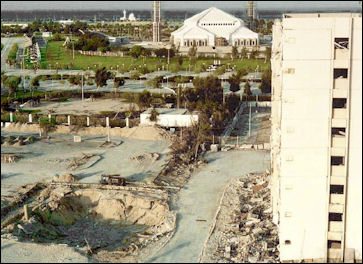
Huge crater left by 1996
Khobar Towers bombing Most Al-Qaida attacks have been bombings. Simultaneous, multiple explosions are trademarks of an Al-Qaida attack. The bombs are often made according to descriptions in Al-Qaida training manuals and sometimes are made with the help of an Al-Qaida bombmakers sent to the country where the attacks are made. To successfully pull off a large vehicle-bomb attack requires a support network and infrastructure at a location and secrecy while assembling the bomb and packing into a vehicle. Numbers have be filed off to avoid detection. To do all this requires a certain level of sophistication.
Al-Qaida attacks often have the following things in common: 1) they use suicide attackers; 2) a single attack consists of several attacks coordinated to occur around the same time; 3) the goal is cause to a maximum number of American — of Western — casualties; 4) meticulous long-term planning; and 5) no warning. In addition to the attacks themselves, Al-Qaida has been able to cause great disruptions through threats of attacks and planting messages for phony attacks.
Al-Qaida members are known for doing careful reconnaissance of their targets and checking out different ways to set off bombs. Among the things they look for are lots of glass which can be shattered into deadly projectiles with a large explosion. Notes from one plot on a U.S. target mentioned one promising site with “an acre and half of glass” and then suggested blowing it up with a bomb in a parked car next to the site or a rented room inside it. Reconnaissance reports have included details like the locations of security cameras, when guards take lunch and cigarette breaks, and the type of weapons they were armed with.
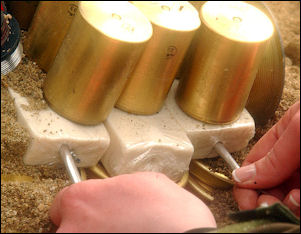
Making a bomb with
C4 plastic explosives There are worries that Al-Qaida might use a Stinger-style missile to strike a jet. Before September 11th weapons were smuggled to Al-Qaida by air from Dubai to Pakistan and then overland to Afghanistan. Land routes through Iran were used. Sometimes, it was rmoured, smugglers were killed after making their deliveries.
Many Al-Qaida attacks have an amateurish quality. In the Casablanca bombing in 2003, for example, the terrorists seemed to have gotten two fountains mixed up. Instead of setting off their bomb at a fountain outside the entrance of a Jewish cemetery, which appears to have been the target, they set it off at a small public fountain two blocks away and managed to only kill themselves and three young Muslims. The attackers also struck a Belgian consulate when it seemed the real target was a Jewish-owned restaurant. The attack on the Jewish community center occurred on the Jewish Sabbath when the center was closed and empty. Even though Jews were thought to be the primary target no Jews were killed.
See Other articles with individual attacks
Al-Qaida Terrorist Handbook and Manual
Al-Qaida recruits in the Afghanistan camps were taught with a 180-page, 18-chapter Arabic-language handbook entitled “Military Studies in the Jihad Against the Tyrants.” Chapter 14 was devoted to assassinations and kidnapings using rifles and pistols. Chapter 15 focused on assassinations with with explosives while Chapter 16 gave tips on assassinations using poisons and cold steel (knives).
There were also tips on lying to interrogators, forging documents, making booby traps, setting up safe houses, shaving one’s beard and assassinating someone using spoiled meat, green beans and corn. Explosives are “believed to be the safest weapon” because they allow fighters to “get away from the enemy personnel and to avoid being arrested.” In addition, “explosives strike the enemy with fear and fright.”

Al-Qaida Training Manual Today most of the information mentioned above can be gleaned from Internet sites. Some Al-Qaida fighters have been taught to kill by slicing off an ear and plunging a knife into the head. For inspiration they watch videotapes of Chechen fighters slitting the throats of Russian soldiers and beheadings from Iraq.
An 11-volume, 5000-page Al-Qaida training manual found in Afghanistan, called “Manual of Afghan Jihad”, listed skyscrapers, nuclear plants and crowded sports stadiums as the best targets for spreading terror in the United States and Europe and also recommended hitting targets with “sentimental value” such as the Statue of Liberty, the Eiffel Tower and Statue of Liberty. It also suggested attacking Jewish organizations and large gatherings of Jews, striking Christmas celebrations and assassinating leaders in Arab nations. Each volume began with a dedication to Osama bin Laden. The preface explained that the manual was complied for the battle against “the enemies of Allah, for any Islamic group.”
There were separate volumes for explosions, first aid, pistols and revolvers, bombs and mines, security and intelligence, tactics, weapons making, tanks, close fighting, topographical surveys and armaments. There were also detailed drawings on how to force cars off the road with motorcycles or other cars and the best whey to penetrate bulletproof vehicles with bullets and bombs.
Al-Qaida training manuals advised using kerosene because it “burns more powerfully than ordinary fueled fires (although it may not be hot enough to melt metal unless it is in very large quantities)” and suggest that “combinations with leaking gas cylinders (esp. oxygen), bleach, ammonia, tires (they burn well) could be lethal.”
Notebooks found in abandoned Al-Qaida hideouts in Kabul revealed plans to: 1) assassinate world leaders in their cars, 2) bomb power stations, and 3) make weapons of mass destruction from chemicals and smuggled nuclear material. The notebooks also had information vital to the investigation of the attack on the World Trade Center in New York on September 11, 2001. Records show Al-Qaida sent followers to enroll in flight schools in the United States. Microsoft Flight Simulator 98 was also found.
Al-Qaida Guide to Bombmaking
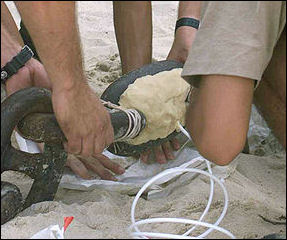
Making a bomb with
C4 plastic explosives Craig Whitlock wrote in the Washington Post: “The 39-page memo recovered from an al-Qaeda laptop computer in Pakistan in 2004 read like an Idiot's Guide to Bombmaking. Forget military explosives or fancy detonators, it lectured. Instead, the manual advised a shopping trip to a hardware store or pharmacy, where all the necessary ingredients for a terrorist attack are stocked on the shelves. [Source: Craig Whitlock, Washington Post, July 5, 2007]
"Make use of that which is available at your disposal and . . . bend it to suit your needs, (improvise) rather than waste valuable time becoming despondent over that which is not within your reach," counseled the author of the memo, Dhiren Barot, a British citizen who said he developed his keep-it-simple philosophy by "observing senior planners" at al-Qaeda training camps. Barot, who was later captured near London and is serving a 30-year sentence, had envisioned an attack with multiple car bombs that would detonate liquid-gas cylinders encased in rusty nails. a strategy with striking similarities to an attempt last week by a suspected terrorist cell to blow up three vehicles in London and Glasgow, Scotland.
“Counterterrorism officials have warned for years that Osama bin Laden and his lieutenants have tried to obtain weapons of mass destruction, such as a nuclear device or chemical or biological weapons. In response, U.S. military and intelligence agencies have invested vast amounts of money to block their acquisition. So far, however, al-Qaeda and its affiliates have relied almost solely on simple, homemade bombs crafted from everyday ingredients -- such as nail-polish remover and fertilizer -- when plotting attacks in Europe and the United States.
The makeshift bombs lack the destructive potential of the conventional explosives... They are also less reliable, as demonstrated by the car bombs that failed to go off in London last week after the culprits tried to ignite them with detonators wired to cellphones. But other attempts have generated plenty of mayhem and damage, including the kitchen-built backpack bombs that killed 52 people in the London public transit system on July 7, 2005. "It makes no difference to your average person if somebody puts a car bomb out there that is crude or one that is sophisticated," said Chris Driver-Williams, a retired British major and military intelligence officer who studies explosive devices used by terrorist groups. "If it detonates, all of a sudden you've got a very serious device and one that has achieved exactly what the terrorists wanted."
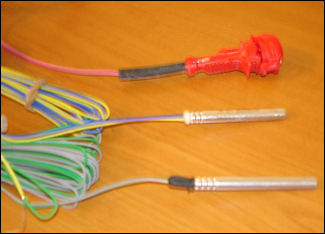
detonators “The advantages of homemade explosives are that they are easy and cheap to manufacture, as well as difficult for law enforcement agencies to detect. According to one expert, the peroxide-based liquid explosives that an al-Qaeda cell allegedly intended to use to blow up nine transatlantic airliners last summer would have cost as little as $15 a bomb. It is technically simple to make such explosives. Instructions are widely available on the Internet. Experts added, however, that it takes skill and sophistication to construct a viable bomb by adding timing devices, detonators or secondary charges.
Investigations have found evidence that most al-Qaeda cells involved in bombing plots in Europe have received training in camps in Pakistan or Afghanistan, or were tutored by graduates of those camps. Among them: cell members involved in the July 7, 2005, bombings in Britain and a separate plot two weeks later that also targeted the London subway. The suspected ringleaders of the May 16, 2003, bombings in Casablanca were also al-Qaeda camp veterans who had experimented in explosives. Richard Reid, who tried to blow up an American Airlines flight from Paris to Miami in 2001, was taught how to build his shoe bomb in Afghanistan.
Al-Qaeda “Masters Terrorism On the Cheap"
Craig Whitlock wrote in the Washington Post: “Since the Sept. 11, 2001, attacks, al-Qaeda has increasingly turned to local cells that run extremely low-cost operations and generate cash through criminal scams, bypassing the global financial dragnet set up by the United States and Europe. Although al-Qaeda spent an estimated $500,000 to plan and execute the Sept. 11 attacks, many of the group's bombings and assaults since then in Europe, North Africa and Southeast Asia have cost one-tenth as much, or less. [Source: Craig Whitlock, Washington Post, August 24, 2008]
“The cheap plots are evidence that the U.S. government and its allies fundamentally miscalculated in assuming they could defeat the network by hunting for wealthy financiers and freezing bank accounts, according to many U.S. and European counterterrorism officials. In an ongoing trial in London of eight men accused of planning to blow up airliners bound for the United States two years ago, jurors have been told how the accused shopped at drugstores for ingredients to build bombs that would have cost $15 apiece to assemble. Similarly, the cell responsible for the July 7, 2005, transit bombings in London needed only about $15,000 to finance the entire conspiracy, including the cost of airfare to Pakistan to consult with al-Qaeda supervisors, according to official British government probes.
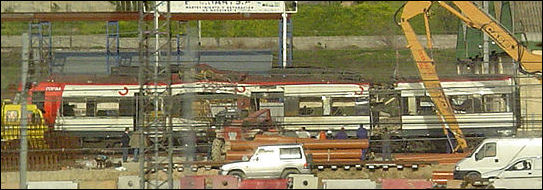
Madrid bombing in 2004
“Investigations into several plots in Europe have shown that operatives were often flush with cash, raising far more than necessary through common criminal rackets such as drug dealing and credit card theft. Testimony in the trial of the accused airliner plotters has shown that the defendants had enough money to buy a northeast London apartment for $260,000 shortly before their arrest, allegedly so they would have a safe place to mix liquid explosives for their bombs.
“In Spain, the cell responsible for the March 2004 train bombings in Madrid needed $80,000 to finance the plot, according to Spanish court documents. But they had access to more than $2.3 million worth of hashish and other illegal drugs that they could have sold to raise more money, the documents showed. Even the 9/11 hijackers wired back about $26,000 in surplus funds to accounts in the Persian Gulf area a few days before the attacks.
Al-Qaida Sought Advice on Justify Attacks That Kill Lots of People
Alan Cullison wrote in The Atlantic Monthly: “Concerned that the heavy casualties inflicted by 1998 U.S. embassy attacks in Kenya and Tanzania (220 dead and over 4,000 injured) would tarnish its image even among its supporters, al-Qaeda actively sought religious and legal opinions from Islamic scholars around the world who could help to justify the killing of innocents. [Source: Alan Cullison, The Atlantic Monthly, September 2004, from files found on a computer used Al-Qaida leader Ayman al-Zawahiri]
The following letter, dated September 26, 1998, six weeks after the embassy bombings and five weeks after the American cruise missile retaliation, is presumably a typical request for theological guidance. “Dear highly respected — I present this to you as your humble brother — concerning the preparation of the lawful study that I am doing on the killing of civilians. This is a very sensitive case — as you know — especially these days. It is very important that you provide your opinion of this matter, which has been forced upon us as an essential issue in the course and ideology of the Muslim movement.

London bombings in 2005
“[Our] questions are: 1) Since you are the representative of the Islamic Jihad group, what is your lawful stand on the killing of civilians, specifically when women and children are included? And please explain the legitimate law concerning those who are deliberately killed. 2) According to your law, how can you justify the killing of innocent victims because of a claim of oppression? 3) What is your stand concerning a group that supports the killing of civilians, including women and children? ...With our prayers, wishing you success and stability.
Al-Qaida and Ambitious Spectacular Attacks
In November 2003, a United Nations report said that Al-Qaida planned to use chemical and biological weapons in a future attack and the only thing that holding them back was “the technical complexity to operate them properly and effectively.” Al-Qaida is still very interested in attacking the United States — and the bigger and badder the strike the better as far as it is concerned. Al-Qaida has said that if it obtains a nuclear device it will only use it on the United States. The United States has said it will retaliate with nuclear weapons if it is attacked with biological or chemical weapons and it would use military and covert force to preempt the use of weapons of mass destruction against it.
According to an Al-Qaida member arrested in Jordan in April 2004, his Al-Qaida cell, which had links to with links to Abu Musab Zarqawi of Al-Qaida in Iraq, was planning a bomb and poison gas attack against the U.S. embassy, the home of the Jordanian royal family, and other targets and hoped to kill 80,000 people. The conspirators received $170,000 from Zarqawi. Some of the money was spent on purchasing 20 tons of chemicals. Al-Qaida also reportedly hatched one scheme in which a number of suicide bombers would detonate their devises in a large sporting event such as an NBA basketball game, with the hope of producing thousands of causalities as people panic and storm towards the exits, and trample and crush each other. The idea was inspired by mass deaths in Mecca and Iraq that occurred during panics at large gatherings.
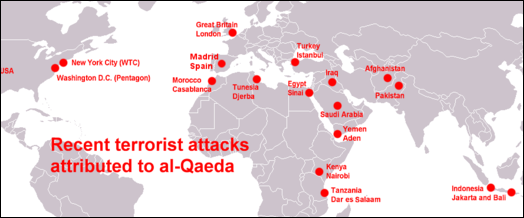
Major Terrorist Attacks by Al-Qaida
David Ignatius wrote in the Washington Post: “Before his death, Osama bin Laden boldly commanded his network to organize special cells in Afghanistan and Pakistan to attack the aircraft of President Barack Obama and Gen. David Petraeus. "The reason for concentrating on them," the al-Qaida leader explained to his top lieutenant, "is that Obama is the head of infidelity and killing him automatically will make (Vice President Joe) Biden take over the presidency. ... Biden is totally unprepared for that post, which will lead the U.S. into a crisis. As for Petraeus, he is the man of the hour ... and killing him would alter the war's path" in Afghanistan. Administration officials said the Obama-Petraeus plot was never a serious threat. The scheme was described in one of the documents taken from bin Laden's compound by U.S. forces on May 2, the night he was killed. [Source: David Ignatius, Washington Post , March 18, 2012]
Bin Laden and his aides hoped for big terrorist operations to commemorate the 10th anniversary of Sept. 11, 2001. Greg Miller and Karen DeYoung wrote in the Washington Post: “In handwritten journals and long-winded compositions saved on computer hard drives, the officials said, bin Laden always seemed to be searching for a way to replicate the impact of al-Qaeda’s most devastating strike. He exhorted followers to explore ways to recruit non-Muslims “who are oppressed in the United States,” in the words of one official — particularly African Americans and Latinos — and to assemble a plot in time for the 10th anniversary of the Sept. 11 attacks. [Source: Greg Miller and Karen DeYoung, Washington Post, May 12, 2011]
Osama bin Laden and a top lieutenant discussed the make-up of a team of militants to attack the United States on this year’s 10th anniversary of 9/11 AFP reported: Notebooks and computer files seized in the raid that killed bin Laden revealed that the terrorist leader was bent on more attacks against US and Western targets. Bin Laden wanted to strike at major US cities, including Los Angeles, and to hit trains as well as airplanes, and mentioned key dates such as America’s July 4 Independence Day celebrations and the upcoming 10th anniversary of the September 11 attacks, they said. [Source: AFP, July 11, 2011]
Ambitious Al-Qaida Plans That Were Foiled or Never Carried Out
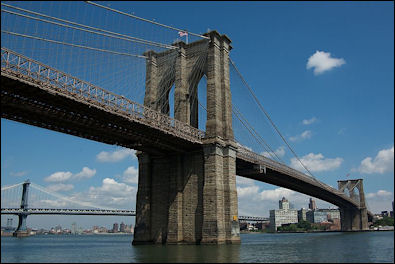
Brooklyn Bridge To mark the beginning of new millennium in 2000, terrorists linked with Al-Qaida planned to bomb Los Angeles International Airport, bridges and tunnels around New York, a U.S. destroyer in Aden and tourist sights in Jordan. All three plots were discovered before they could be carried out . The plot was broken after the “millennium bomber” Ahmed Ressam was captured crossing from Canada into Washington state with explosives and detonators in his car. There were also reports that attacks were to take place in conjunction with the election in 2004 but those didn’t happen either.
The New York Times reported: “George J. Tenet, the former director of the Central Intelligence Agency, wrote in his autobiography that the authorities were concerned that Qaeda operatives had made plans in 2003 to attack the New York City subway using cyanide devices. Zawahri reportedly called off the plot because he feared that it “was not sufficiently inspiring to serve Al Qaeda’s ambitions,” and would be viewed as a pale, even humiliating, follow-up to the 9/11 attacks. [Source: Eric Schmitt and Thom Shanker, New York Times, March 18, 2008]
Plans to blow up the Brooklyn Bridge were foiled before they could be carried out. In 2002, Iyman Faris, a naturalized American citizen from Kashmir, began casing the Brooklyn Bridge to plan an attack and communicated with Qaeda leaders in Pakistan via coded messages about using a blowtorch to sever the suspension cables. But by early 2003, Mr. Faris sent a message to his confederates saying that “the weather is too hot.” American officials said that meant Mr. Faris feared that the plot was unlikely to succeed — apparently because of increased security.
In a speech in October 2005, U.S. President Bush said 10 Al-Qaida plots had been foiled: 1) the use of hijacked planes to attack the West Coat in mid 2002; 2) the use of hijacked planes to attack the East Coast in mid 2003; 3) the dirty bomb attack; 4) the bombing of several sites in Britain in mid 2004; 5) attacks on Westerners in several places in Karachi in spring 2003; 6) an attack London’s Heathrow Airport using hijacked commercial planes; 7) a large scale bombing in Britain in the spring of 2004; 8) an attack on ships in Arabian Gulf in in late 2002 and 2003; 9) attack on ships in the Straits of Hormuz in 2002; and 10) an attack on a tourist sight outside the United States in 2003.
In September 2008, Western intelligence agencies uncovered an Al-Qaeda plot to launch attacks in Britain, France and Germany by Pakistan-based extremists to punish Europe, and France in particular. The BBC and Sky News said commando-style teams of militants planned to seize Western hostages and murder them in a manner similar to the attacks in Mumbai in 2008 in which 10 gunmen killed 166 people and injured more than 300 in three luxury hotels, a railway station and restaurants. [Source: Alice Ritchie, AFP, September 28, 2010]
Even though anti-American sentiments are very high it seems unlikely that a September 11thlevel attack will occur. Al-Qaida is much less powerful as a large unit able to carry out spectacular attacks plus Americans are much more vigilant and security is tighter. Terrorists find it much easier to operate in relatively lawless places like Yemen and Somalia.
Trans-Atlantic Aircraft Plot in 2006

The New York Times reported: “On the night of Aug. 9, 2006, British authorities arrested 24 men and charged them with plotting to blow up as many as 10 trans-Atlantic flights, using explosive liquids that were to have been smuggled aboard the airliners in soda bottles.
The bombs consisted of liquid explosive inserted by syringes into plastic soft-drink bottles. [Source: New York Times]
In all, 10 men faced charges in the case over three trials - one that ended in 2008, another that was concluded in 2009 and a third that ended in July 2010 - and all but two were convicted. Documents found at the plotters' homes and on a computer memory stick belonging to the plot ringleader showed that they had earmarked airline schedules for seven flights leaving London for New York, Washington, Chicago, San Francisco, Montreal and Toronto, with aircraft operated by American Airlines, United Airlines and Air Canada. Evidence at the trial showed that the plot aimed to detonate the bombs nearly simultaneously, with the aircraft over the Atlantic.
The case was quickly whittled down to eight defendants, amid widening public skepticism of the scale of the plot. The eight went on trial in London in April 2008, charged with conspiring to murder thousands of people by carrying out the attacks on passenger jets bound for North America. On Sept. 9, 2008, the jury found three of the eight guilty of conspiracy to commit murder. But it returned no verdict on the most serious charges, involving a conspiracy to blow up airliners. Rashid Rauf, a British militant who was a liaison to Al Qaeda and was a main suspect in the bombing plot, was killed on Nov. 23, 2008, in a missile strike by an American aircraft in northern Pakistan. Mr. Rauf's detention in August 2006 had led to the arrests of 25 others, but all charges against him were later dropped.
On Feb. 17, 2009, prosecutors began a second trial of the eight men by telling a jury that the accused planned to cause deaths on an "unprecedented scale" and to strike "a blow that would reverberate across the world." The new trial was widely viewed among counterterrorism officials on both sides of the Atlantic as the most important to be held in Britain since the Sept. 11 attacks in the United States. The significance was all the greater because there have been no trials yet of anyone directly involved in the Sept. 11 attacks.
The jury found three men guilty of conspiring to kill passengers and crew members aboard the flights. A British high court judge gave all three men the maximum of life imprisonment, but followed standard British practice by specifying the minimum period each man would have to serve before becoming eligible for parole. The plot's ringleader in Britain, Abdulla Ahmed Ali, was given a minimum term of 40 years. Assad Sarwar received a 36-year minimum and a third man, Tanvir Hussain was told he would have to serve at least 32 years.
The wider implications of the plot were its worldwide impact on airline security. The bombs for the attacks led to tight new restrictions on the liquids and creams passengers can take onto flights. The restrictions remain in force worldwide, causing major backups for passengers already confronted with the time-consuming airport security measures introduced after the September 11 attacks.

Batillus supertanker
Al-Qaida’s Plans to Blow Up Oil Tankers
There are concerns that Al-Qaida could get its hands on a tanker carrying liquified petroleum gas (easier to explode than natural gas) and 1) explode it near a densely populated area; 2) ram it into a cruise ship or a famous landmark; 3) or use it to block the Panama Canal, Suez Canal, Bosporus or Malacca Straits.
Matt Apuzzo of AP wrote: Osama bin Laden's personal files revealed a brazen idea to hijack oil tankers and blow them up at sea in the summer of 2010, creating explosions he hoped would rattle the world's economy and send oil prices skyrocketing, the U.S. said. The plot showed that while bin Laden was always scheming for the next big strike that would kill thousands of Americans, he also believed a relatively simple attack on the oil industry could create a worldwide panic that would hurt Westerners every time they gassed up their cars. [Source: Matt Apuzzo, AP May 21 2011]
U.S. officials said the tanker idea, included in documents found in the compound where bin Laden was killed, was little more than an al-Qaida fantasy. But the FBI and the Homeland Security Department issued a confidential warning to police and the energy industry that al-Qaida had sought information on the size and construction of oil tankers and had decided that spring and summer provided the best weather to approach the ships. The group had determined that blowing them up would be easiest from the inside and believed an explosion would create an "extreme economic crisis."
With about half the world's oil supply moving on the water, industry and security experts have warned for years that such an attack would be a jolt to global markets. That's particularly true if terrorists carried it out in one of the narrow waterways that serve as shipping chokepoints. "You start blowing up oil tankers at sea and you're going to start closing down shipping lanes," said Don Borelli, senior vice president of the Sufan Group security firm and a former FBI counterterrorism agent in New York. "It's going to cause this huge ripple through the economy."
Shippers have been on particular alert as threats of piracy have increased along the African coast. In 2008, Somali pirates captured the Sirius Star supertanker and held it for ransom. In 2007 the Japanese tanker the Golden Nori was hijacked carrying 40,000 tons of the highly explosive chemical benzene. Intelligence officials initially worried that terrorists might try to crash the boat into an offshore oil platform or use it as a gigantic bomb, but it proved to be another attack by pirates seeking ransom. Then in 2010, two groups of pirates got into a shootout while arguing over the ransom for the Maran Centaurus, threatening to turn the ship into a massive fireball.
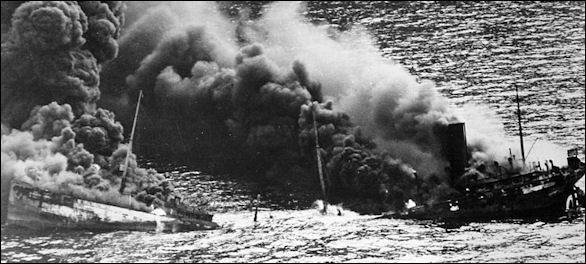
Tanker blown up by a torpedo in World War II
Pirates have had success with a relatively low-tech strategy. They fire at a ship to get it to slow down, then pull alongside in skiffs. Using lashed-together ladders or grappling hooks, the pirates climb on board with guns. Many ship owners are reluctant to have armed guards onboard, since the cargo is so flammable that sailors are even forbidden to smoke. Somali pirates take the ships for money. The information taken from bin Laden's compound after he was killed May 2 suggests al-Qaida was interested in adapting that strategy to terrorize.
The U.S. has warned for years that such an attack in a narrow waterway, such as the Strait of Hormuz between Oman and Iran, would immediately send oil prices higher. In Asia, concerns have centered on the continent's key oil chokepoint, the Strait of Malacca, located between Indonesia, Malaysia, and Singapore. Last year, an Indonesian al-Qaida affiliate set up a training camp at the beginning of the strait, leading to speculation about an attack there and prompting Singapore to issue a warning.
"The good thing is that boats don't move that fast. It gives you plenty of time to interdict," said Crispian Cuss, the program director at Olive Group, one of the biggest private security companies in the Middle East. "If a vessel was hijacked by an al-Qaida organization and headed toward a major port, the authorities would not let that vessel get anywhere near that port."
Al-Qaida and Weapons of Mass Destruction
In 1998, when Osama bin Laden asked if he had nuclear or chemical weapons, he responded: "Acquiring weapons for the defense of Muslims is a religious duty. If I have indeed acquired these weapons, then I thank God for enabling me to do so." In November 2001, Pakistan’s Dawn newspaper reported that Osama bin Laden said that Muslim extremists possessed nuclear weapons and he might use nuclear and chemical weapons in response to U.S. attacks. Bin Laden is reported to have said, “If America used chemical and nuclear weapons against us we may retort with chemical and nuclear weapons. We have the weapons as a deterrent.”
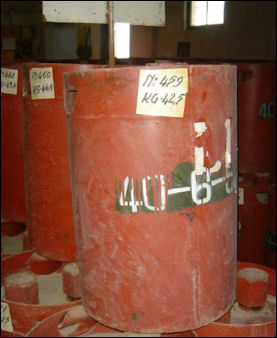
Albanian chemical weapon canister David Ignatius wrote in the Washington Post: “Even as al-Qaeda was preparing to fly its airplane bombs into buildings, the group was also trying to acquire nuclear and biological capabilities. In August 2001, bin Laden and his deputy, Ayman al-Zawahiri, met around a campfire with Pakistani scientists from a group called Umma Tameer-E-Nau to discuss how al-Qaeda could build a nuclear device. Al-Qaeda also had an aggressive anthrax program that was discovered in December 2001 after bin Laden was driven from his haven in Afghanistan. [Source: David Ignatius, Washington Post, October 18, 2007]
“Al-Qaeda proclaimed a religious rationale to justify the WMD attacks it was planning. In June 2002, a Kuwaiti-born cleric named Suleiman Abu Ghaith posted a statement on the Internet saying that "al-Qaeda has the right to kill 4 million Americans" in retaliation for U.S. attacks against Muslims. And in May 2003, at the same time Saudi operatives of al-Qaeda were trying to buy three Russian nuclear bombs, a cleric named Nasir al-Fahd issued a fatwa titled "A Treatise on the Legal Status of Using Weapons of Mass Destruction Against Infidels." Interrogations of al-Qaeda operatives confirmed that the planning was serious. Al-Qaeda didn't yet have the materials for a WMD attack, but it wanted them.
“Most chilling of all was Zawahiri's decision in March 2003 to cancel a cyanide attack in the New York subway system. He told the plotters to stand down because "we have something better in mind." What did that mean?...Years later, we still don't know.
Al-Qaida and Chemical and Biological Weapons
Al-Qaida is believed to possess the ingredients for crude chemical weapons such as chorine and phosgene poisonous gases but does not possess more sophisticated chemical agents such as sarin nerve gas. At the Afghanistan training camps, some recruits were trained with gas masks and taught how to use cyanide gas. Manuals with instructions on how to use chemical weapons were found in a laboratory with cannister of foul-smelling liquids in an Al-Qaida safe house.
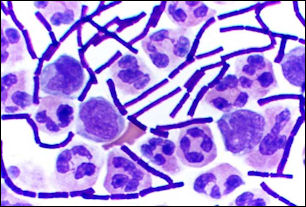
Anthrax Al-Qaida also lacks the a good system to disperse such agents. They could possibly use crop-dusting planes or hand sprayers. One Al-Qaida terrorist was found with manuals describing crop dusting equipment. Before September 11th, Osama bin Laden ordered 200 gas masks and 200 spacesuits designed to protect wearers from chemical and biological weapons.
Biological agents that Al-Qaida may trying to exploit for a terrorist attack might include smallpox, inhalation anthrax, pneumonic plague, botulism, tularemia and hemorrhagic fevers (like Ebola), Manuals have been found at Al-Qaida-linked site with instructions on how to use biological weapons. One contained a recipe on how to make ricin, a deadly biological poison. Ricin is a protein derived from castor oil seed. It was used famously to kill a Bulgaria spy in London in 1978. There were also indications Al-Qaida might be trying to build an anthrax bomb. Al-Qaida has reportedly experimented with ricin. A group found with ricin in Britain reportedly had Al-Qaida connections.
Communications Between Al-Qaida Leadership on Biological Weapons
A message to Muhammad Atef from al-Zawahiri, dated April 15, 1999, read: “I have read the majority of the book [an unnamed volume, probably on biological and chemical weapons] — [It] is undoubtedly useful. It emphasizes a number of important facts, such as: a) The enemy started thinking about these weapons before WWI. Despite their extreme danger, we only became aware of them when the enemy drew our attention to them by repeatedly expressing concerns that they can be produced simply with easily available materials — b) The destructive power of these weapons is no less than that of nuclear weapons. c) A germ attack is often detected days after it occurs, which raises the number of victims. d) Defense against such weapons is very difficult, particularly if large quantities are used. [Source: Alan Cullison, The Atlantic Monthly, September 2004, from files found on a computer used by Al-Qaida leader Ayman al-Zawahiri]
“I would like to emphasize what we previously discussed — that looking for a specialist is the fastest, safest, and cheapest way [to embark on a biological- and chemical-weapons program]. Simultaneously, we should conduct a search on our own. Along these lines, the book guided me to a number of references that I am attaching. Perhaps you can find someone to obtain them.” The letter goes on to cite mid-twentieth-century articles from, among other sources, Science, The Journal of Immunology, and The New England Journal of Medicine, and lists the names of such books as Tomorrow's Weapons (1964), Peace or Pestilence (1949), and Chemical Warfare (1921).
Cullison wrote: Al-Zawahiri and Atef appear to have settled on the development of a chemical weapon as the most feasible option available to them. Their exchanges on the computer show that they hired Medhat Mursi al-Sayed, an expert to whom they refer as Abu Khabab, to assist them. They also drew up rudimentary architectural plans for their laboratory and devised a scheme to create a charitable foundation to serve as a front for the operation. According to other sources, Abu Khabab gassed some stray dogs at a testing field in eastern Afghanistan, but there is no indication that al-Qaeda ever developed a chemical weapon it could deploy.”
See Separate Article AYMAN RAI AL-ZAWAHIRI AND AL-QAIDA factsanddetails.com
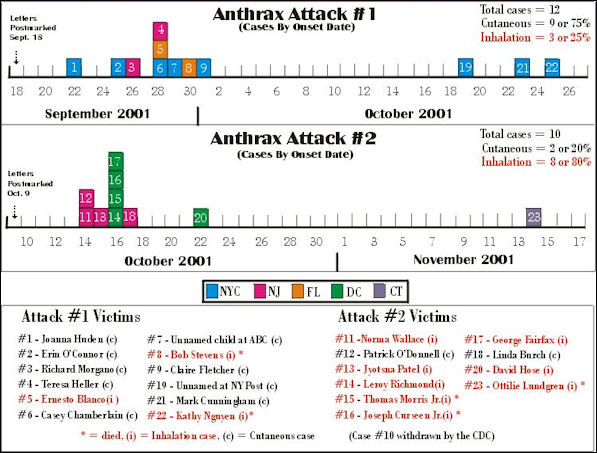
2001 American anthrax attacks likely carried out by American
Al-Qaida and Nuclear Weapons
Osama bin Laden reportedly told a Pakistani reporter that nuclear weapons could be purchased on the Central Asian black market for $10 million to $20 million. Sultan Bashiruddin Mahmood and Abdul Majid — two Pakistani nuclear scientists who worked on Pakistan’s nuclear weapons program — aid they worked in Afghanistan and reportedly met with Osama bin Laden. Mahmood’s son said that Mahmood was asked by Osama bin Laden if he would help Al-Qaida to build a bomb. Mahmood said no.
Steven Coll wrote in the Washington Post: “His inspiration, repeatedly cited in his writings and interviews, is the American atomic bombing of Hiroshima and Nagasaki, which he says shocked Japan's fading imperial government into a surrender it might not otherwise have contemplated. Bin Laden has said several times that he is seeking to acquire and use nuclear weapons not only because it is God's will, but because he wants to do to American foreign policy what the United States did to Japanese imperial surrender policy. Listening to him on tape after tape, it is difficult to doubt bin Laden's intent. There is evidence that he and his allies have experimented with chemical and biological weapons, typically low-level toxins. But in public, bin Laden talks mainly about nuclear bombs. [Source: Steven Coll, Washington Post, February 2005]
Plans to build crude nuclear weapons were found at an Al-Qaida hideout in Kabul. Low-grade uranium-238, cyanide and other poisonous chemicals were found in an Al-Qaida storage faculty near the Kandahar airport. Making a nuclear weapons is beyond Al-Qaida’s capabilities. Uranium-238 can not be used to make a nuclear bomb. There is o evidence that Al-Qaida possesses plutonium or weapons-grade uranium that can be used to make a nuclear devise.
In February 2004, the pan-Arab newspaper Al-Hayat reported that Al-Qaida had obtained tactical nuclear weapons from Ukraine and was storing them for future use. According to the story the weapons were purchased in Kandahar, Afghanistan from Ukrainian scientists who carried the weapons in suitcase. The story had an Islamabad, Pakistan dateline and came from an Al-Qaida source. There have been no independent corroborations of the report.
In April 2010, U.S. President Barack Obama said that efforts by al Qaeda to acquire atomic weapons posed the biggest threat to global security, and world leaders must act with urgency to combat this danger. Obama, speaking on the eve of a 47-nation summit in Washington aimed at thwarting nuclear terrorism, said he expected "enormous progress" at the conference toward the goal of locking down loose nuclear material worldwide. "The central focus of this nuclear summit is the fact that the single biggest threat to U.S. security -- both short-term, medium-term and long-term -- would be the possibility of a terrorist organization obtaining a nuclear weapon," Obama told reporters. "We know that organizations like al Qaeda are in the process of trying to secure a nuclear weapon -- a weapon of mass destruction that they have no compunction at using." [Source: Ross Colvin and Caren Bohan, Reuters, April 11, 2010]
.jpg)
American B-61 nuclear bomb
Al-Qaida reportedly has been trying to get their hands on nuclear material from Russia and South Africa since the early 1990s. Mohammed El-Baradei of the International Atomic Energy Agency (the United Nations nuclear watchdog) told a Norwegian television station that Al-Qaida tried to obtain nuclear weapons base on Al-Qaida documents found in Afghanistan in 2001.
David Ignatius wrote in the Washington Post: “Rolf Mowatt-Larssen is paid to think about the unthinkable. As the Energy Department's director of intelligence, he's responsible for gathering information about the threat that a terrorist group will attack America with a nuclear weapon. With his shock of white hair and piercing eyes, Mowatt-Larssen looks like a man who has seen a ghost...He is convinced that al-Qaeda is trying to acquire a nuclear bomb. [Source: David Ignatius, Washington Post, October 18, 2007]
“Mowatt-Larssen argues that for nearly a decade before Sept. 11, al-Qaeda was seeking to acquire weapons of mass destruction. As early as 1993, Osama bin Laden offered $1.5 million to buy uranium for a nuclear device, according to testimony presented in federal court in February 2001...After 2004, the WMD trail went cold, according to Mowatt-Larssen. Many intelligence analysts have concluded that al-Qaeda doesn't have nuclear capability today. Mowatt-Larssen argues that a more honest answer is: We don't know.”
Al-Qaida, Uranium and Dirty Bombs
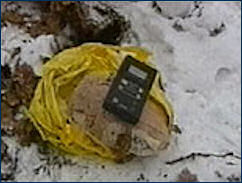
Moscow dirty bomb Al-Qaida is believed to have the capability to make a make a “dirty bomb.” Diagram of dirty bombs were found in an Al-Qaida hide out in Afghanistan. Most showed radioactive material wrapped around a nail bomb or fertilizer-made bomb. Many of the designs however were so crude they probably would not work.
The BBC reported that Al-Qaida had constructed a crude “dirty bomb” with medical isotopes near Herat, Afghanistan based on documents uncovered by the British military and intelligence.
After the American invasion of Afghanistan in 2001 and 2002 a variety of dangerous materials were found stored in hundreds of drums, jars and metal cases in an underground Al-Qaida base near Kandahar and a Taliban compound in Kabul. It was originally thought that some of these material might be radioactive and could be used to make a radiological or “dirty bomb.” Tests showed none of the materials were radioactive.
In late 1993, one Al-Qaida member tried to buy $1.5 million worth of uranium. The deal didn’t go through because the man wasn’t sure the uranium was the real thing. Mostly likely it was bogus. There are reports that Al-Qaida may have been duped on other occasions and spent large sums of money for fake uranium.
Pakistan, Al-Qaida and Nuclear Weapons

weapons-grade uranium Two Pakistani scientists — Bashir ud Din Mahmoud and Chowdhury Mohammed Amjad — worked in Pakistan’s nuclear program and were supporters of the Taliban. They may have given information on building nuclear weapons or provided information on the whereabouts of Pakistan’s nuclear arsenal to Al-Qaida.
Mahmoud designed Pakistan’s plutonium-producing reactor. He once wrote on a website that the Taliban “are not people in power but upholders of a movement — the movement of the renaissance of Islam in the world. Simple proof of this is that all anti-Islamic forces are united in opposition to them. In the holy Koran, Allah told us, “All kufr [disbelief] will unite against the haq, truth, of Islam. Today the world is witness of this truth.”
Image Sources: Wikimedia Commons
Text Sources: New York Times, Washington Post, Los Angeles Times, Times of London, The Guardian, National Geographic, The New Yorker, Time, Newsweek, Reuters, AP, AFP, Wall Street Journal, The Atlantic Monthly, The Economist, Global Viewpoint (Christian Science Monitor), Foreign Policy, Wikipedia, BBC, CNN, NBC News, Fox News and various books and other publications.
Last Updated July 2012
